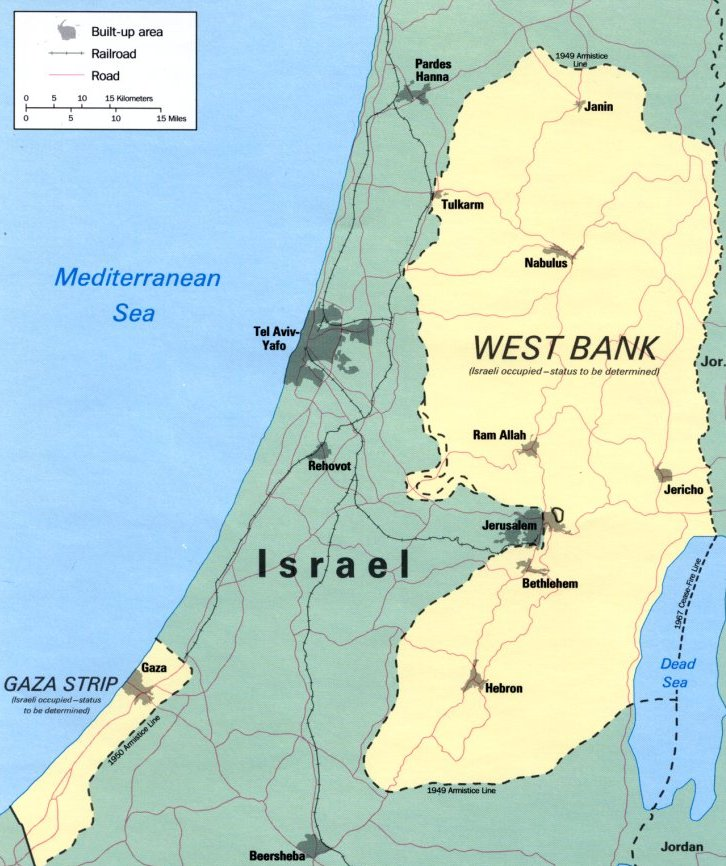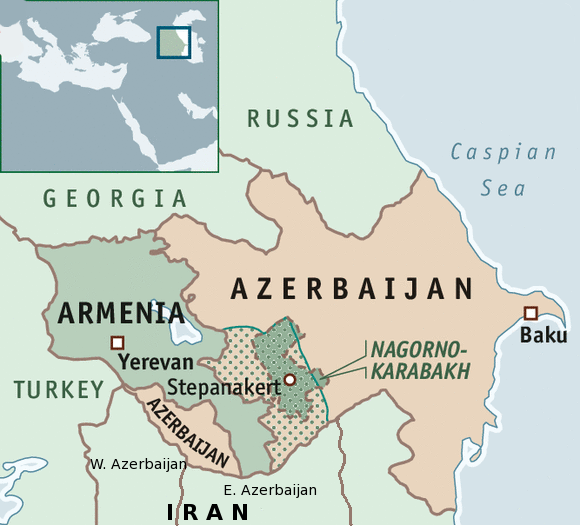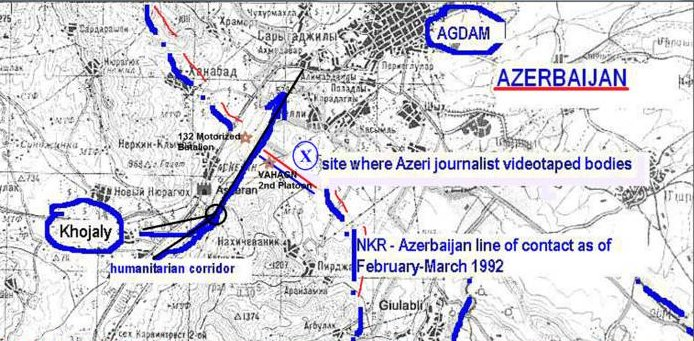It’s bad enough that massacres, pogroms and genocides occur, but how does one categorize claims made for such crimes later to be proven to be hoaxes? Massacres and mass murders occur, but when such events are deliberately magnified for political purposes it is an insult to those who may have indeed lost their lives in those events.
Two cases are examined herein based on their stark similarities: (1) claims made for the now widely debunked April 2002 Israeli massacre of Palestinians in the West Bank town of Jenin, and (2) lesser known claims made for the 1992 “genocide” of Azerbaijanis by Armenians in Khojaly, a town in Nagorno-Karabakh, a majority Armenian-populated region bounded by Azerbaijan and Armenia. See map below. New Azerbaijani video evidence has appeared across the internet making for a unique comparison of these two “events”.
Briefly, Nagorno-Karabakh was placed under Azerbaijani jurisdiction as an autonomous oblast by the Soviets in the early 1920s, but it declared its independence from Azerbaijan in 1991 according to then-existing Soviet law. As the Soviet Union fell apart, peaceful demands for Nagorno-Karabakh to be either independent of Azerbaijan or united with Armenia resulted in pogroms of Armenians across Azerbaijan and the expulsion of Azerbaijanis from Armenia. Eventually, a full-scale war ensued between Azerbaijan and the Armenians of Nagorno-Karabakh. A ceasefire was signed in May, 1994. The present semi-frozen conflict over Nagorno-Karabakh is based on the conflicting, although generally accepted, tenets of territorial integrity and the right of an indigenous population for self-determination.
The purpose of this article is not to provide reasons, military justifications, or the history behind each of these events or conflicts, but rather to place in context the amplification and widening of each event, manufactured for political purposes.
Jenin
References to the official UN investigation refuting claims of a massacre of Palestinians on the scale of genocide in Jenin abound. See accompanying map for its relative location. The following is a short overview. On April 1, 2002, the Israeli Defense Force (IDF) entered Jenin and two days later entered the Jenin refugee camp. This was done after Israelis determined Jenin was a coordination center for attacks in Israel proper. A week and a half long battle ensued between the IDF and Palestinian fighters. On April 11, Palestinian fighters surrendered, and a week later IDF began a withdrawal. Initially, during the fighting, Israel estimated up to 200 Palestinians may have died. However, accounts of the mass murder of Palestinians on the scale of what took place in Bosnia and Kosovo began to appear in the international press. BBC reported “Jenin ‘massacre evidence growing’”. CNN reported “Israeli troops killed as many as 500 people”. It was also claimed that “thousands of Palestinians were either killed and buried in massive graveyards or smashed under houses destroyed in Jenin and Nablus”. Investigations confirmed 23 Israeli soldiers and 52 Palestinians were killed, and “up to half of the Palestinian dead may have been civilians”.
In an attempt to increase the perception of a large death count a fake funeral was held in Jenin, the results of which were embarrassing. See various clips on youtube, as well as other places. Israelis also claim bodies were exhumed from cemeteries and buried en masse with recently killed Palestinian fighters. In addition, “IDF senior officials reported … on Israeli television that animal carcasses were also hauled to the refugee camp to create the “stench of death””.

Location and Relative Position of Jenin: Northern Edge of the West Bank
Claims were made that “survivors described bodies deliberately mutilated by Israeli troops”. Photos supposedly from Jenin were actually from other places. All in all, independent investigations clearly showed events in Jenin were bad, but it was neither mass murder nor acts reaching genocidal proportion.
Khojaly
Indeed, a great loss of life occurred in late February 1992 in Khojaly, Nagorno-Karabakh. We can add their deaths to the approximately 30,000 who lost their lives in this conflict.

Location of the Region of Nagorno-Karabakh Relative to Armenia and Azerbaijan
Khojaly was used by Azerbaijan as a staging ground for the continuous shelling of Stepanakert, the capital of the then Nagorno-Karabakh Autonomous Oblast. Months of shelling contributed to the near-total destruction of Stepanakert. Clearly, from a military and survival perspective, the Azerbaijani shelling from Khojaly had to end. Neutralizing the sources of shelling and rocket fire is typical in any war. However, the neutralization of the Khojaly staging ground by the Nagorno-Karabagh forces was transformed into a rallying cry for a demoralized Azerbaijani army; led to the ouster of then Azerbaijani president, Ayaz Mutalibov; and, most importantly, was exploited by Azerbaijan to advance a claim that Armenians committed some form of mass atrocity. Having been subjected to genocide at the hands of the Turkish government during WWI, as well as experienced horrific pogroms across Azerbaijan from 1988 to 1990, Armenians were now put on the defensive by the Azerbaijani claim that they committed genocide on the inhabitants of Khojaly. It did not matter that such an event did not fit the definition of genocide; it sounded bad enough even as an informal fallacy.
Over a period of many months, what appeared to have been another unfortunate loss of human life in this war took on a propagandistic, disinformation life of its own. Initially, the event went unreported in the Azerbaijani press. Slowly, reports noted several casualties; then, scores of dead; then, sometime before September 1992, “official Baku” reported 159 dead to Human Rights Watch. Today, the count claimed is 613 as read on multiple Azerbaijani internet sites and stated by the Azerbaijani government. It is nearly impossible to verify the statistics that the Azerbaijani government used to generate their numbers. In addition, there are no available statistics on the number of dead Azerbaijani soldiers in this count. Moreover, semi-official Azerbaijani groups claim to have names of Khojaly dead topping 800 plus. Some Azerbaijani human rights groups claim 1,600 dead. As recently as two years ago, the Azerbaijan American Alliance claimed 1,000 dead.
Much of Khojaly’s death count resulted from Azerbaijani fighters interspersed among civilian evacuees who were being escorted by Armenians through a humanitarian corridor. Reports state that during this transport, shooting began, and then escalated, resulting in a large number of casualties in the crossfire. It is quite possible that up to a hundred civilians ended up dying in the crossfire, the rest having been Azerbaijani soldiers; however, this is only a guess, because there is no reliable data to base anything higher or lower.
Not only were unverifiable death counts blamed on Armenians, accusations of widespread mutilations were also directed against Armenians in Azerbaijani posters, books, and magazines. Today, these falsehoods are all over social media and theme web sites. Azerbaijan and its representatives periodically show a purported 1992 Khojaly photo of a mother grieving over her five dead children. However, that photograph is from the Erzurum earthquake in Turkey published in the Turkish Hurriyet newspaper on October 30, 1983. This fake photo was, for quite some time, the predominant document presented by Baku as proof of a “massacre” or “genocide” in Khojaly. Not surprisingly, as years have passed, the embarrassment of multiple exposés of this clearly fake photo has resulted in its removal from Azerbaijani-sponsored sites. If Khojaly events were genocidal, it would not be necessary to use photographs taken a decade earlier in a different country. This same 1983 Turkish photo has been used to show the aftermath of the 1982 massacres of Palestinians at Lebanon’s Sabra and Shatila refugee camps.
A sampling of fake and anachronistic photos includes a black and white image (third photo down) on the web page of the Supreme Court of the Republic of Azerbaijan, claimed to be the result of Armenian barbarism in Khojaly. However, this photo is taken from a color photo of the massacre in Racak, Kosovoin January 1999.
Photos taken by Azerbaijanis of mutilated bodies show no signs of blood around the mutilations. This is not how human anatomy responds to punctures inflicted on a live body, but the absence of blood does correspond to bodies that have been dead for some time – on the order of at least 6-12 hours, depending on conditions. This is indicative of lividity, the gravitational pooling of blood away from the top of the bodies where many mutilations are seen.
New Video Evidence
Two videos bearing new information on the Khojaly events have surfaced recently. The first video is by a famous Azerbaijani military journalist, Chingiz Mustafayev. The second video is part of Mustafayev’s testimony in an official inquiry on the events in and around Khojaly. Both original videos are in Azerbaijani Turkish and some copies have Russian, or English subtitles.*
These videos corroborate each other, as well as support other evidence that dead bodies were transported many kilometers outside Khojaly, placed in a field, and mutilated subsequently by Azerbaijani soldiers. After the mutilations, the world press was specifically invited to the site, and the massacre or genocide that wasn’t was created. As incredible as it sounds, these latest videos clearly lead to this conclusion.
Armenians have insisted for years that the dead bodies were moved and then mutilated. It has taken 25 years for these known videos to finally surface. During his first helicopter video, on February 28, 1992, 2-3 days after the Khojaly events, Mustafayev witnessed a field full of bodies on the Azerbaijani side of the contact line. Two days later, he passed over the same field in a helicopter and witnessed Azerbaijani soldiers amongst the same bodies who had subsequently been mutilated. In addition, a Czech journalist, Dana Mazalova, in an interview with Ayaz Mutalibov, the Azerbaijani president at the time who was later ousted, reveals the following:
“Question (by Mazalova): What is your opinion about the Khojaly events after which you resigned? Dead bodies of the Khojaly inhabitants were found not far from Aghdam. Someone first shot at legs so that people could not go farther. Then they were finally killed with axes. On the 29th of February my colleagues surveyed all of this. Then during a new survey taken on 2nd March these same corpses were scalped. A very strange game. Mutalibov: As the Khojaly inhabitants, who narrowly escaped, say, it was all organized in order to have ground for my resignation”.
In this interview, Mutalibov also talks about the humanitarian corridor provided by Armenians and how it is not in their nature to have deliberately caused this tragedy. The point here is not the ouster of Mutalibov, but the assertions by independent eyewitnesses, Dana Mazalova and her colleagues, which corroborate Mustafayev’s helicopter video runs – first showing bodies having been transported, and then, two days later, witnessing the bodies having been mutilated on the Azerbaijani side of the contact line. Interestingly, Mazalova visited Mustafayev in Baku in mid-March, 1992, where she wrote that she saw the same video that was just released on the internet showing a field of non-mutilated bodies under the control of Azerbaijani soldiers; then, upon Mustafayev’s return to the same site, as described in the video, there were naked bodies of women, children, and scalped men.
The accompanying map shows how the manufactured events associated with Khojaly in fact took place on the Azerbaijani side of the line of contact, 10-15 km from Khojaly and the humanitarian corridor created by the Armenians. Being under Azerbaijani control, Mustafayev was able on two separate occasions to fly in Azerbaijani helicopters over the area where the dead bodies were.
Chingiz Mustafayev died under mysterious circumstances in August 1992, and until his death he demanded that events such as Khojaly be provided with real explanations.

Region of Interest: Khojaly, location of bodies, and line of contact
Claims leveled in the Jenin and Khojaly events have been debunked subsequently. However, events in Jenin were investigated within weeks by UN and other international bodies. In the case of Khojaly, it has taken nearly 25 years for corroborating evidence from an Azerbaijani military journalist to surface in support of the Armenian position that Azerbaijan exaggerated massively and outright lies about the events in the aftermath of the tragedy in Khojaly. During these 25 years, Azerbaijanis have used their manufactured claims appearing to be victims of a crime against humanity. Baku has even had limited international recognition and support for their Khojaly claims. Perhaps we should thank Chingiz Mustafayev’s brother, Vahid, who is rumored to have released these videos. Azerbaijani authorities shut down his Baku TV station, ANS, in July 2016. In a February 24, 2017 interview, former Azerbaijani President Ayaz Mutalibov called Chingiz Mustafayev a national traitor over his lawsuits and public demands for the truth behind the events that became known as the “Khojaly genocide”.
Chart Comparing Events in Jenin, West Bank, and Khojaly, Nagorno-Karabakh
| Event (associated with claimants) |
Jenin |
Khojaly |
| Actual deaths |
53 (verified) |
159 (unverifiable) |
| Deaths claimed |
500-1000s |
Several – 1600 |
| Dead bodies moved |
✔ |
✔ |
| Fake videos made their way into the world press |
✔ |
✔ |
| Fake photos from different times and places made their way into the world press, purportedly representing reality |
✔ |
✔ |
| Additional dead bodies used to increase death count |
✔ |
✔ |
| Claims of bodies mutilated after death |
✔ |
✔ |
| Authorities of accused admit massive loss of life |
✔ |
✔ |
| The accused themselves were subject to well-known genocides at some time in recent history |
✔ |
✔ |
| Claims made to impress world opinion and/or for multiple parochial alternative political motives |
✔ |
✔ |
* It is possible that some of the latest links may not be available; taken down, moved, etc., by the time this article reaches publication.


